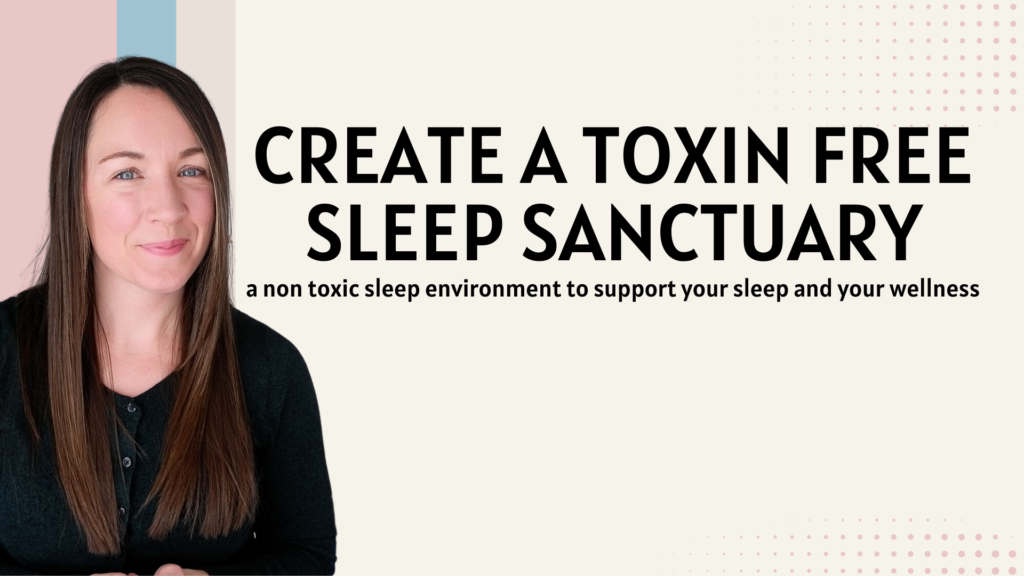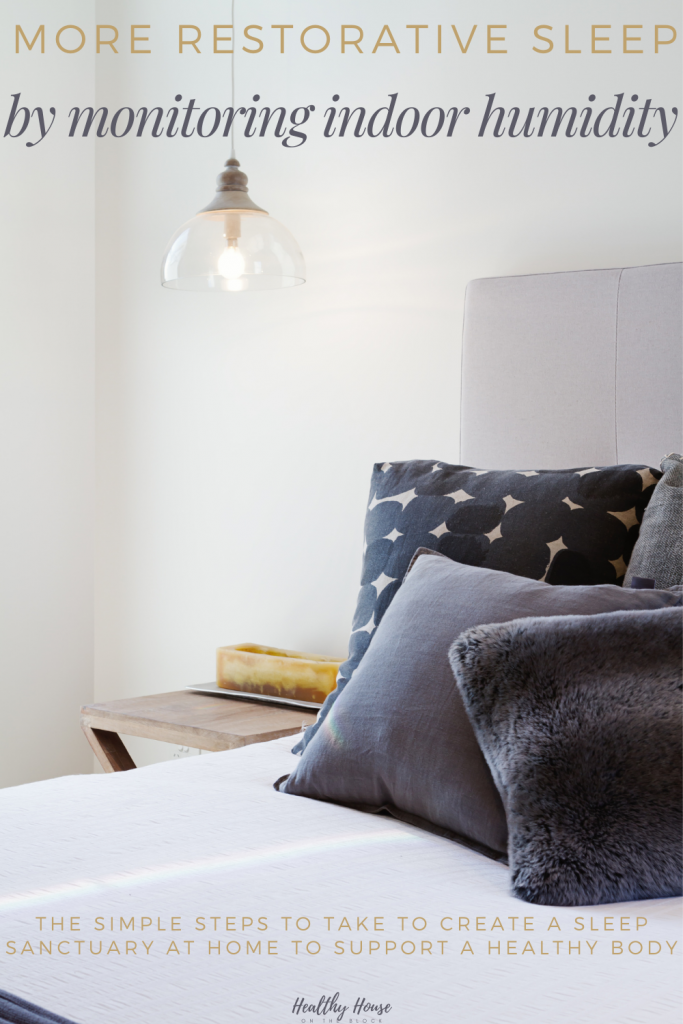
If you’re having trouble sleeping, my guess is you’ve already started down the road to find a solution. Changing your sleeping environment to be a low toxin space is one of the best ways to help your body. It creates a restorative place while teaching your body just how to sleep. Creating a healthy room to make sure you’re not having trouble sleeping can be the key to a great night sleep.
When we talk about a low toxin or toxin free space, it’s more than just a place with moderately improved indoor air quality. It’s a restorative place that is free from endocrine disruptors, sleep disrupting elements and organic toxins.
A healthy house is more than just a space free from toxins and mold. A healthy house is the foundation and start of a healthy life in whole. We wouldn’t expect an apple to stay fresh if we stored it in a wet paper bag outside. It’s the same thought with our home. It’s been said that our house is like a second skin to our bodies, creating benefits or problems.
Where we sleep is a place that we should take extra precaution about. It’s an area that we will end up spending about one third of our lives in. If we are in one particular environment more often, we should make sure it’s a healthy and safe environment to be in.
I’m so excited to share with you the basic elements of a healthy sleep sanctuary in your own home. Not only will it enlighten you on he how to sleep in the healthiest ways, but it will help you unburden your body and start a solid foundation to a healthy lifestyle.
HOW TO SLEEP: KEY ELEMENTS TO HELP YOU REST & RESTORE NATURALLY
One of the BIGGEST reasons so many products and articles focus on how to sleep is due to the fact that it’s extremely important to our health and wellness. We know those of us who suffer from poor or deficiency sleep have a greater risk of high blood pressure, diabetes, stroke, obesity, heart disease and kidney disease (STUDY)
And why does sleep matter so much? Sleep is one of the biggest contributors to a healthy lifestyle. When we get proper rest and sleep our body has time to repair itself from day to day stressors as well as detoxify the brain. When you’re rested you can function on a higher level. In fact this study released reveals that sleep helps our brain flush out many of the toxins we come in contact with while we’re sleeping. (STUDY) Improving your sleep environment can drastically change the quality of your day.
It’s true that your house can cause insomnia. When we don’t know how to sleep in a healthy way, we deprive ourselves of this natural detoxifying habit, our health suffers. One study done associates poor indoor air quality with a disruption of sleep caused by small particles that get into our blood stream. These particles then affect the regulation of sleep within our brain. (STUDY)
Another interesting study shows that household habits, materials and products can cause sleep disturbances, trouble falling asleep and chronic insomnia in adults and in children (STUDY). So what are the biggest factors when it comes to knowing the importance of how to sleep and creating a sleep sanctuary for your body?
- Controlling moisture levels and maintaining a healthy relative humidity level
- Removing and eliminating as much dust as possible
- Using low toxin bedding and pillows
- Opting for an organic mattress
- Keeping electronics out of your bedroom space

The Perfect Humidity Levels
Controlling the humidity in a bedroom is a great way to ensure organic toxins such as mold and mildew don’t affect your space. Humidity is also important because an area that has high indoor humidity is an area that is conducive to dust mite reproduction. The lower the humidity, the dust mites will end up dying off.
High humidity in an area where you’re staying for a long period of time can also cause congestion in many individuals. Nasal congestion is caused by inflamed blood vessels in the nose which cause swelling of nasal tissue. And if you’ve tried to fall asleep while being congested, you know that it’s not an easy task. Congestion can also cause snoring and mouth breathing which tend to be sleep disruptors. The fact that your house can cause insomnia and sleep deprivation means we need to be careful of the indoor climate.
In addition to all of this, when a room has higher levels of humidity, any volatile organic compounds inside the space will off gas at a higher rate. These VOCs come from your building materials and furnishings in your room.
Humid spaces encourage VOC off gassing and these levels can quickly become elevated and concentrated in your room, especially with the door closed at night.
The important thing to remember is that you don’t want to pull all the moisture out of your air. If you’re air is too dry your nasal passages, skin and eyes will be extremely itchy and irritated. We know that the ideal indoor humidity level is somewhere between 35% – 45%. You can monitor your humidity levels with an inexpensive hygrometer to see where your bedroom stands.

Get Rid of Dust
Dust is everywhere, even if you feel like you have an extremely clean house. And where there’s dust, there’s sure to be dust mites. Bedrooms are a real problem spot when it comes to dust as we shed skin and sweat all when we’re sleeping on our mattress. This means that where humans spend the most time, there will be more dust. Most of the time we would just shrug this little fact off and perhaps vacuum a little bit more. But let me be the first to tell you this is NOT the way to handle extra dust in your bedroom.
Dust mites are a serious disruption to our bodies respiratory system and their skin and excrement are toxic to our bodies. So making sure your room has as little dust as possible is important.
Specifically speaking, dust mites cause an allergic reaction within our upper respiratory system such as a runny nose and hay fever. They also cause irritation in the lungs and eyes as well as sneezing. That doesn’t sound like the magic potion for sleep to me. The National Sleep Foundation also states that dust mites cause general immune system stress, which means you could be getting sick more often. These are all ways that dust and dust mites in your bedroom can really disrupt your sleep.
In addition to all of this, dust contains toxins like phthalates, pesticides, formaldehyde and flame retardants. All of these toxins either come in from outside or they come from our textiles around our space.
Once these toxins end up in our dust, we can be exposed through ingestion as it settles on surfaces or through inhalation as it gets pushed up into the air.
The only way to reduce this toxin exposure is to get rid of dust all together.

Reduce Toxins from Bedding
Toxins can be such a broad term. Specifically though, I’m talking about the toxins that are added to your bedding and pillows. We know that toxins are a disruptor to our endocrine system as well as an external irritant. Our endocrine system hold our thyroid and pineal gland, both are responsible for helping us fall asleep and stay asleep.
By allowing toxins from our bedding such as bleach, formaldehyde, flame retardants and pesticides to surround us for 7-8 hours a day, we are really overworking our immune system. This could lead to sleep disruptions that turn into sleep deprivation, or it could be insomnia.
Many of the chemicals that are added to our bedding and pillows such as polyurethane foams, formaldehyde (for a wrinkle free texture) and flame retardants release harmful VOCs constantly. When our bodies are in direct contact with these materials, producing both humidity and warmth, the VOCs actually off-gas at a higher, more potent rate.
These chemicals like formaldehyde, flame retardants, microplastics and pesticides within the fibers can also become dislodged. Once this happens, the toxins end up in dust around our room and air, creating an unhealthy space that exposes us to toxins by ingestion and inhalation.
These posts will help you plan out toxin free bedding in your home:

How to Sleep on a Toxin Free Organic Mattresses
Mattresses are IMPERTIVE when you’re trying to improve how to sleep. They are the BIGGEST factor when it comes to toxin prevention and can be one of the BEST options in terms of removing current toxins from your sleeping space.
If you google this topic you will find a plethora of blog posts and websites showing you the problems with the modern mattress and the toxins that are added to make it “safe.” When our hormones and brain function is disrupted by the toxins in a mattress THAT WE SLEEP DIRECTLY ON, there’s no telling what the effect could hold.
The other side of that is the external irritants. Many of the chemicals in our mattresses can cause itchy throat and eyes as well as skin issues. These irritating conditions can make it very difficult to fall asleep.
The biggest offending toxins are the flame retardants they coat mattresses in. Initially this concept was added to prevent a fire if someone fell asleep with a cigarette in their mouth. Mattresses are covered in flame retardants now so they can withstand the heat and flame of a blow torch. Unless you’re sleeping with a blow torch nearby, it seems as though this practice may be unnecessarily causing some serious health issues. These same flame retardants were studied in a lab with mice. When the mice were exposed to the chemical toxins their brains became overly hyperactive. A hyperactive brain does not allow us to easily fall asleep, causing insomnia or sleep deprivation.
The other chemical offenders to where we sleep is the polyurethane foam they put in mattresses, which emits VOCs, a known endocrine system disruptor as well as an external irritant.
Formaldehyde has also been found in mattresses, which causes asthma, allergies and lung cancer. What we sleep on can be just as important as where we sleep when it comes to a healthy environment.
These toxins above are just the tip of the iceberg when it comes to our mattresses. This post about toxins in mattresses is a really in-depth look at just HOW these toxins are affecting our bodies with studies and links to back up that point.

EMFs
In the case for the link that your house can cause insomnia and sleep disorders, there is a lot to be said for electromagnetic fields. While there is still a lot left unknown about EMFs, what we have learned is they are a disruptor to our bodies. There are two ways that EMFs disrupt our body’s natural sleep process.
First we must understand that our body has natural electromagnetic fields. Our natural EMFs vibrate at a low number of cycles. Electromagnetic fields from electronics vibrates at a higher rate of oscillation. The discrepancy between these two rates of humans and electronics is what can prevent you from falling asleep. They have also found that the higher vibrations of unnatural EMFs can pull you out of a deep sleep, which will disrupt your sleep process, leaving you tired. A study performed in 1999 showed that magnetic fields in the same room as a sleeping person caused a decreased time in REM sleep as well as a broken sleep pattern.
The same study also that showed the pineal gland’s production of melatonin, which helps you fall asleep was decreased when individuals were exposed to more EMFs during the day. THat’s right, your exposure to electromagnetic fields during the day can actually inhibit your sleep at night.
The other way that electronics and electromagnetic fields can disrupt your sleep is by the light given off by the electronics that create the EMFs. When you watch TV or look at your phone, your body’s natural response to the blueish light is to decrease the production of melatonin. Melatonin is what your pineal gland produces to help you fall asleep and stay asleep. This is why we sleep in dark rooms and why it’s generally easiest for us to fall asleep at night.
This post all about reducing electronics in your space will help you get started.

Learning how your house can keep you healthy is a great way to start changing your habits and lifestyle. We know now that your house can cause insomnia, sleep deprivation and other disturbances during sleep. We also know that sleep is one of the most important factors of a healthy lifestyle.
Our sleep allows us to function on a higher level, and also allows our brain to detoxify. Help your sleep by helping your sleep environment first.
Share this:
- Click to share on Facebook (Opens in new window) Facebook
- Click to share on LinkedIn (Opens in new window) LinkedIn
- Click to share on Reddit (Opens in new window) Reddit
- Click to share on Pinterest (Opens in new window) Pinterest
- Click to print (Opens in new window) Print
- Click to share on X (Opens in new window) X




Decorating your room to make it a silent sanctuary is a great idea. Great thoughts and thanks for sharing.
Thank you – glad it was helpful!
Hi, I enjoyed your post on a “Sleep Sanctuary”. I am looking for non-toxic bedroom furniture. Do you have any suggestions?
Pingback: Overhaul Your Healthy Home: Create a Non Toxic Space Quickly »